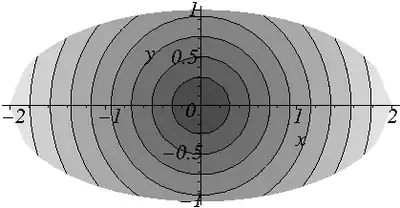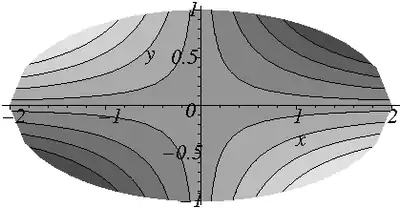Warping Function and Torsion of Non-Circular Cylinders
The displacements are given by
where is the twist per unit length, and is the warping function.
The stresses are given by
where is the shear modulus.
The projected shear traction is
Equilibrium is satisfied if
Traction-free lateral BCs are satisfied if
or,
The twist per unit length is given by
where the torsion constant
Example 1: Circular Cylinder
Choose warping function
Equilibrium () is trivially satisfied.
The traction free BC is
Integrating,
where is a constant.
Hence, a circle satisfies traction-free BCs.
There is no warping of cross sections for circular cylinders
The torsion constant is
The twist per unit length is
The non-zero stresses are
The projected shear traction is
Compare results from Mechanics of Materials solution
and
Example 2: Elliptical Cylinder
Choose warping function
where is a constant.
Equilibrium () is satisfied.
The traction free BC is
Integrating,
where is a constant.
This is the equation for an ellipse with major and minor axes and ,
where
The warping function is
The torsion constant is
where
If you compare and for the ellipse, you will find that . This implies that the torsional rigidity is less than that predicted with the assumption that plane sections remain plane.
The twist per unit length is
The non-zero stresses are
The projected shear traction is
 Shear stresses in the cross section of an elliptical cylinder under torsion |
For any torsion problem where S is convex, the maximum projected shear traction occurs at the point on S that is nearest the centroid of S
The displacement is
 Displacements () in the cross section of an elliptical cylinder under torsion |
Example 3: Rectangular Cylinder
In this case, the form of is not obvious and has to be
derived from the traction-free BCs
Suppose that and are the two sides of the rectangle, and . Also is the side parallel to and is the side parallel to . Then, the traction-free BCs are
A suitable must satisfy these BCs and .
We can simplify the problem by a change of variable
Then the equilibrium condition becomes
The traction-free BCs become
Let us assume that
Then,
or,
Case 1: or
In both these cases, we get trivial values of .
Case 2:
Let
Then,
Therefore,
Apply the BCs at ~~ (), to get
or,
The RHS of both equations are odd. Therefore, is odd. Since, is an even function, we must have .
Also,
Hence, is even. Since is an odd function, we must have .
Therefore,
Apply BCs at ~~ (), to get
The only nontrivial solution is obtained when , which means that
The BCs at are satisfied by every terms of the series
Applying the BCs at again, we get
Using the orthogonality of terms of the sine series,
we have
or,
Now,
Therefore,
The warping function is
The torsion constant and the stresses can be calculated from .
Prandtl Stress Function ()
The traction free BC is obviously difficult to satisfy if the cross-section
is not a circle or an ellipse.
To simplify matters, we define the Prandtl stress function
using
You can easily check that this definition satisfies equilibrium.
It can easily be shown that the traction-free BCs are satisfied if
where is a coordinate system that is tangent to the boundary.
If the cross section is simply connected, then the BCs are even simpler:
From the compatibility condition, we get a restriction on
where is a constant.
Using relations for stress in terms of the warping function , we get
Therefore, the twist per unit length is
The applied torque is given by
For a simply connected cylinder,
The projected shear traction is given by
The projected shear traction at any point on the cross-section is tangent to the contour of constant at that point.
The relation between the warping function and the Prandtl stress
function is
Membrane Analogy
The equations
are similar to the equations that govern the displacement of a membrane that is stretched between the boundaries of the cross-sectional curve and loaded by an uniform normal pressure.
This analogy can be useful in estimating the location of the maximum
shear stress and the torsional rigidity of a bar.
- The stress function is proportional to the displacement of the membrane from the plane of the cross-section.
- The stiffest cross-sections are those that allow the maximum volume to be developed between the deformed membrane and the plane of the cross-section for a given pressure.
- The shear stress is proportional to the slope of the membrane.
Solution Strategy
The equation is a Poisson equation. Since the
equation is inhomogeneous, the solution can be written as
where is a particular solution and is the solution of the homogeneous equation.
Examples of particular solutions are, in rectangular coordinates,
and, in cylindrical co-ordinates,
The homogeneous equation is the Laplace equation , which is satisfied by both the real and the imaginary parts of any { analytic} function () of the complex variable
Thus,
Suppose .
Then, examples of are
where , , , are constants.
Each of the above can be expressed as polynomial expansions in the
and coordinates.
Approximate solutions of the torsion problem for a particular cross-section
can be obtained by combining the particular and homogeneous solutions
and adjusting the constants so as to match the required shape.
Only a few shapes allow closed-form solutions. Examples are
- Circular cross-section.
- Elliptical cross-section.
- Circle with semicircular groove.
- Equilateral triangle.
There are a few other papers which propose closed-form or semi-closed-form solutions to the torsion problem for cross-sections with irregular shapes [1][2][3].
Example: Equilateral Triangle
 Torsion of a cylinder with a triangular cross section |
The equations of the three sides are
Let the Prandtl stress function be
Clearly, at the boundary of the cross-section (which is what we need for solid cross sections).
Since, the traction-free boundary conditions are satisfied by , all
we have to do is satisfy the compatibility condition to get the value of
. If we can get a closed for solution for , then the stresses
derived from will satisfy equilibrium.
Expanding out,
Plugging into the compatibility condition
Therefore,
and the Prandtl stress function can be written as
The torque is given by
Therefore, the torsion constant is
The non-zero components of stress are
The projected shear stress
is plotted below
 Stresses in a cylinder with a triangular cross section under torsion |
The maximum value occurs at the middle of the sides. For example, at ,
The out-of-plane displacements can be obtained by solving for the warping function . For the equilateral triangle, after some algebra, we get
The displacement field is plotted below
 Displacements in a cylinder with a triangular cross section. |
Thin-walled Open Sections
Examples are I-beams, channel sections and turbine blades.
We assume that the length is much larger than the thickness , and that does not vary rapidly with change along the length axis .
Using the membrane analogy, we can neglect the curvature of the membrane in the direction, and the Poisson equation reduces to
which has the solution
where is the coordinate along the thickness direction.
The stress field is
Thus, the maximum shear stress is
Thin-walled Closed Sections
The Prandtl stress function can be approximated as a linear
function between and on the two adjacent boundaries.
The local shear stress is, therefore,
where is the parameterizing coordinate of the boundary curve of the cross-section and is the local wall thickness.
The value of can determined using
where is the area enclosed by the mean line between the inner and outer boundary.
The torque is approximately
Related content
- ↑ Approximate Torsional Analysis of Multi-layered Tubes with Non-circular Cross-Sections, Gholami Bazehhour, Benyamin, Rezaeepazhand, Jalil, Journal: Applied composite materials ISSN: 0929-189X Date: 12/2011 Volume: 18 Issue: 6 Page: 485-497 DOI: 10.1007/s10443-011-9213-z
- ↑ Simplified approach for torsional analysis of non-homogenous tubes with non-circular cross-sections, B Golami Bazehhour, J Rezaeepazhand, Date: 2012: Journal: International Journal of Engineering, Volume: 25, Issue: 3,
- ↑ Torsion of tubes with quasi-polygonal holes using complex variable method, Gholami Bazehhour, Benyamin, Rezaeepazhand, J. Journal: Mathematics and mechanics of solids ISSN: 1081-2865 Date: 05/2014 Volume: 19 Issue: 3 Page: 260-276 DOI: 10.1177/1081286512462836